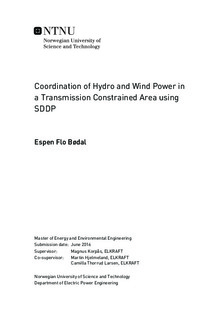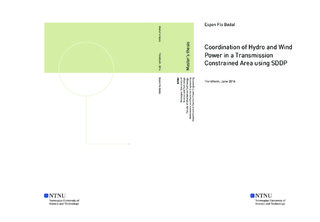| dc.description.abstract | As a part of the initiative to reduce the effects of climate change by moving towards increased shares of energy from renewable sources Norway and many other European countries has stated clear targets described in the Energy Directive. In Norway the main mechanism to achieve this goal is at present the green-certificate market which is a common effort by Norway and Sweden to increase the amount of electricity production from renewable energy sources. Both Norway and Sweden has good conditions for renewable energy production from hydro and wind power, but these resources are often in rural areas where the transmission grid is weak. The weak grid represents an additional cost to implementing renewable energy sources as it requires significant investments in construction of new transmission lines. By controlling the storable hydro power in the region with respect to wind power production and thus utilize the transmission lines more efficiently the required investments in transmission capacity can be reduced and large amounts of renewable energy sources can be faster and more efficiently integrated.
A medium-term hydro power scheduling model based on stochastic dual dynamic programming is customized and used to study the effects from coordination of hydro and wind power production in a transmission constrained area while considering stochastic inflow and wind. The model is used in a case study for a future scenario of a region in western Norway with large potential for small hydro power and wind power development where the system is studied for different levels of transmission and wind power capacity. The main objective of the study is to give a general assessment on the effects of coordination of hydro and wind power in a transmission constrained area including the impact on spillage, revenue, reservoir strategy and grid-utilization.
Results from the case study show that large amounts of wind power can be integrated in a system dominated by storable hydro power, even if the transmission capacity is limited, without significantly increasing the energy loss. Coordination results in a lower reservoir level and a shift in storable hydro power production towards lower power levels which reduces spillage and wind curtailment. The export of energy out of the system increases when coordinating and duration on the transmission lines are shifted towards intermediate levels. Revenue is moved from storable hydro power to run-of-river hydro and wind power as coordination results in moved storable hydro power production to less profitable periods. | |

